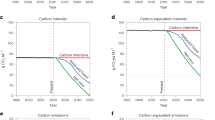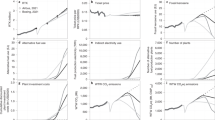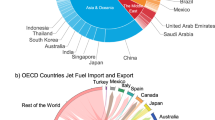Abstract
In response to strong growth in air transportation CO2 emissions, governments and industry began to explore and implement mitigation measures and targets in the early 2000s. However, in the absence of rigorous analyses assessing the costs for mitigating CO2 emissions, these policies could be economically wasteful. Here we identify the cost-effectiveness of CO2 emission reductions from narrow-body aircraft, the workhorse of passenger air transportation. We find that in the US, a combination of fuel burn reduction strategies could reduce the 2012 level of life cycle CO2 emissions per passenger kilometre by around 2% per year to mid-century. These intensity reductions would occur at zero marginal costs for oil prices between US$50–100 per barrel. Even larger reductions are possible, but could impose extra costs and require the adoption of biomass-based synthetic fuels. The extent to which these intensity reductions will translate into absolute emissions reductions will depend on fleet growth.
This is a preview of subscription content, access via your institution
Access options
Subscribe to this journal
Receive 12 print issues and online access
$209.00 per year
only $17.42 per issue
Buy this article
- Purchase on Springer Link
- Instant access to full article PDF
Prices may be subject to local taxes which are calculated during checkout



Similar content being viewed by others
References
CO2 Emissions from Fuel Combustion: Detailed Estimates (International Energy Agency (IEA), 2014).
International Energy Statistics (Energy Information Administration (EIA), 2015); http://www.eia.gov/cfapps/ipdbproject/IEDIndex3.cfm.
Lee, D. S. et al. Aviation and global climate change in the 21st century. Atmos. Environ. 43, 3520–3537 (2009).
Henderson, J. Controlling Carbon Dioxide Emissions from the Aviation Sector (Stratus Consulting, 2005).
Pathways to a Low-Carbon Economy: Version 2 of the Global Greenhouse Gas Abatement Cost Curve (McKinsey & Company, 2009).
Pearce, B. Commercial Airline CO2 and Mitigation Potential (International Air Transport Association, 2009).
Holland, M. et al. A Marginal Abatement Cost Curve Model for the UK Aviation Sector (Department for Transport, 2011).
Morris, J., Rowbotham, A., Angus, A., Mann, M. & Poll, I. A Framework for Estimating the Marginal Costs of Environmental Abatement for the Aviation Sector (Omega Report, 2009).
Raper, D. et al. UK Aviation: Carbon Reduction Futures (Department for Transport, 2009).
Jesse, E., van Aart, P. & Kos, J. Cost-Benefit Studies of Possible Future Retrofit Programmes WP/Task No. D4.2. EC-FP7 RETROFIT Project (Fokker Services, 2012).
Reducing the Impact of Aviation on Climate Change, Economic Aspects of Inclusion of the Aviation Sector in the EU Emissions Trading Scheme Briefing Note IP/A/ENVI/FWC/2005-35 (European Commission (EC), 2006).
Lee, J. J., Lukachko, S. P., Waitz, I. A. & Schäfer, A. Historical and future trends in aircraft performance, cost, and emissions. Annu. Rev. Energy Environ. 26, 167–200 (2001).
Air Carrier Statistics and Financial Reports (Form 41) (Department of Transportation, 2014).
Stratton, R. W., Min Wong, H. & Hileman, J. Quantifying variability in life cycle greenhouse gas inventories of alternative middle distillate transportation fuels. Environ. Sci. Technol. 45, 4637–4644 (2011).
Graham, W. R., Hall, C. A. & Vera Morales, M. The potential of future aircraft technology for noise and pollutant emissions reduction. Transp. Policy 34, 36–51 (2014).
Vera Morales, M., Graham, W. R., Hall, C. A. & Schäfer, A. Techno-Economic Analysis of Aircraft, Deliverable D5 (WP 2 report), Technology Opportunities and Strategies Towards Climate Friendly Transport (EC-FP7 TOSCA) Project (Univ. Cambridge, 2011).
Global Market Forecast 2014–2033 (Airbus Group, 2014); http://airbus.com/company/market/forecast.
Current Market Outlook 2014–2033 (Boeing Commercial Airplanes, 2014); http://www.boeing.com/boeing/commercial/cmo.
Moore, F. C. & Diaz, D. B. Temperature impacts on economic growth warrant stringent mitigation policy. Nature Clim. Change 5, 127–131 (2015).
Aviation Partners Boeing Products-Blended Wingletshttp://www.aviationpartnersboeing.com/index.php.
Airbus Launches Sharklet Retrofit for In-Service A320 Family Aircraft (Airbus Group, 2013); http://www.airbus.com/presscentre/pressreleases/press-release-detail/detail/airbus-launches-sharklet-retrofit-for-in-service-a320-family-aircraft.
Freitag, W. & Schulze, E. T. Blended winglets improve performance. Aero Magazine QTR03, 9–12 (2009).
Avitrader MRO The Price of a Smooth Landing (AviTrader Publications, 2011).
Allen, T., Miller, T. & Preston, E. Operational advantages of carbon brakes. Aero Magazine QTR03, 16–18 (2009).
Scott, A. Jet engine makers battle over performance. Chicago Tribune (16 June 2013); http://articles.chicagotribune.com/2013-06-16/business/sns-rt-us-air-show-enginesbre95f0f2-20130616_1_pratt-engine-cfm-international-leap-engine.
Reals, K. How airlines are losing weight in the cabin. Flightglobal (31 March 2014); http://www.flightglobal.com/news/articles/analysis-how-airlines-are-losing-weight-in-the-cabin-397193.
Berglund, T. Evaluation of Fuel Saving for an Airline Bachelor Thesis, Univ. Mälardalen (2008).
Dzikus, N., Fuchte, J., Lau, A. & Gollnick, V. Potential for fuel reduction through electric taxiing. In 11th AIAA Aviat. Tech. Integr. Oper. (ATIO) Conf. 2011-6931 (American Institute for Aeronautics and Astronautics, 2011).
Hospodka, J. Cost-benefit analysis of electric taxi systems for aircraft. J. Air Transp. Manage. 39, 81–88 (2014).
eTaxi—taxiing aircraft with engines stopped. FAST 51, 2–10 (2013).
EGTS (Electric Green Taxiing System) Safran/Honeywell; http://www.safranmbd.com/systems-equipment-178/electric-green-taxiing-system.
Department of Energy (DOE) US Billion-Ton Update: Biomass Supply for a Bioenergy and Bioproducts Industry (eds Perlack, R. D. et al.) ORNL/TM-2011/224 (Oak Ridge National Laboratory, 2011).
Malina, R. et al. HEFA and F-T Jet Fuel Cost Analyses (MIT, 2012).
Hileman, J. et al. Near-Term Feasibility of Alternative Jet Fuels (RAND and MIT, 2009); http://web.mit.edu/aeroastro/partner/reports/proj17/altfuelfeasrpt.pdf.
Nakahara, A. & Reynolds, T. G. Estimating current & future system-wide benefits of airport surface congestion management. In 10th USA/Europe Air Traffic Manage. Res. Dev. Semin. (ATM Seminar, 2013); http://www.atmseminar.org/seminarContent/seminar10/papers/300-Reynolds_0127130454-Final-Paper-4-17-13.pdf
Clewlow, R., Balakrishnan, H., Reynolds, T. G. & Hansman, R. J. A survey of airline pilots regarding fuel conservation procedures for taxi operations. Int. Airport Rev. 3, 10–13 (2010).
Muller, D., Uday, P. & Marais, K. B. Evaluation of the potential environmental benefits of RNAV/RNP arrival procedures. In 11th AIAA Aviat. Tech. Integr. Oper. (ATIO) Conf. 2011-6932 (American Institute for Aeronautics and Astronautics, 2011).
Poole, R. Air Traffic Control Reform Newsletter No. 87 (Reason Foundation, 2011); http://reason.org/news/printer/air-traffic-control-reform-news-87.
Federal Aviation Administration (FAA) The Business Case for the NextGen Air Transportation System (US Department of Transportation, 2014).
Reynolds, T. G. Analysis of lateral flight inefficiency in global air traffic management. In 26th Congr. Int. Counc. Aeronaut. Sci./8th AIAA Aviat. Tech. Integr. Oper. Conf. (American Institute for Aeronautics and Astronautics, 2008).
Lovegren, J. & Hansman, R. J. Estimation of Potential Aircraft Fuel Burn Reduction in Cruise via Speed and Altitude Optimization Strategies (MIT, 2011); http://hdl.handle.net/1721.1/62196.
Jensen, L., Hansman, R. J., Venuti, J. & Reynolds, T. G. in AIAA Aviation 2013 Conf. 2013-4289 (American Institute for Aeronautics and Astronautics, 2013).
Reynolds, T. G., Ren, L. & Clarke, J.-P. B. Advanced noise abatement approach activities at a regional UK airport. Air Traffic Control Q. 15, 275–298 (2007).
Dumont, J.-M., Reynolds, T. G. & Hansman, R. J. Fuel burn and emissions reduction potential of low power/low drag approaches. In 11th AIAA Aviat. Tech. Integr. Oper. (ATIO) Conf. 2011-6886 (American Institute for Aeronautics and Astronautics, 2011).
Price List Line Maintenance Services for German Stations Only (Lufthansa Technik, 2014); http://www.lufthansa-technik.com/documents/100446/101431/Pricelist+German+Stations+2014.pdf.
Hansen, D. Painting versus polishing of airplane exterior surfaces. Aero Magazine QTR01 (1999).
Dray, L. An analysis of the impact of aircraft lifecycles on aviation emissions mitigation policies. J. Air Transp. Manage. 28, 62–69 (2013).
Global Fleet Database (BACK Aviation Solutions, 2008).
Morrell, P. & Dray, L. Environmental Aspects of Fleet Turnover, Retirement, and Life-Cycle Final Report (Omega, 2009).
Acknowledgements
A.W.S. gratefully acknowledges the financial support provided by Stanford University’s Precourt Energy Efficiency Center. T.G.R.’s contributions are based on work sponsored by the Federal Aviation Administration (FAA) under Air Force Contract FA8721-05-C-0002. Opinions, interpretations, conclusions, and recommendations are those of the authors and are not necessarily endorsed by the United States Government. T.G.R. gratefully acknowledges support from the FAA Office of Environment and Energy.
Author information
Authors and Affiliations
Contributions
A.W.S. led the specification of aircraft technologies and synthetic fuels, the development of the model, the analysis of the results, and the preparation of the manuscript. A.D.E. led the specification of the airline operational strategies, developed elements of the model, and contributed to the analysis of the results and preparation of the manuscript. T.G.R. developed the techno-economic characteristics of air traffic management systems, contributed to those of aircraft technologies and airline operational strategies, and contributed to the analysis of the results and preparation of the manuscript. L.D. developed elements of the model, including underlying fleet databases, and contributed to the analysis of the results and preparation of the manuscript.
Corresponding author
Ethics declarations
Competing interests
The authors declare no competing financial interests.
Supplementary information
Rights and permissions
About this article
Cite this article
Schäfer, A., Evans, A., Reynolds, T. et al. Costs of mitigating CO2 emissions from passenger aircraft. Nature Clim Change 6, 412–417 (2016). https://doi.org/10.1038/nclimate2865
Received:
Accepted:
Published:
Issue Date:
DOI: https://doi.org/10.1038/nclimate2865
This article is cited by
-
Emission pathways and mitigation options for achieving consumption-based climate targets in Sweden
Communications Earth & Environment (2023)
-
Aviation carbon transfer and compensation of international routes in Africa from 2019 to 2021
Scientific Data (2023)
-
Cost and emissions pathways towards net-zero climate impacts in aviation
Nature Climate Change (2022)
-
Evaluating the climate impact of aviation emission scenarios towards the Paris agreement including COVID-19 effects
Nature Communications (2021)
-
Potential for electric aircraft
Nature Sustainability (2019)



